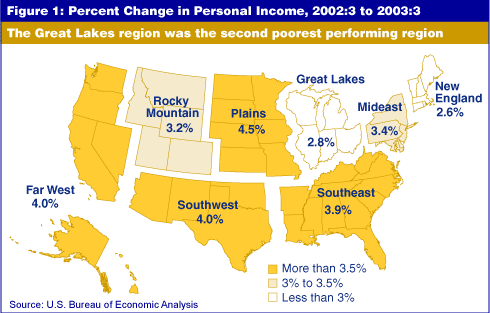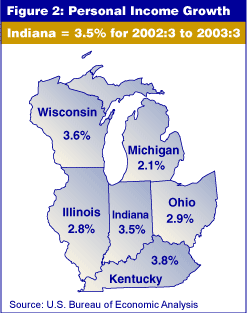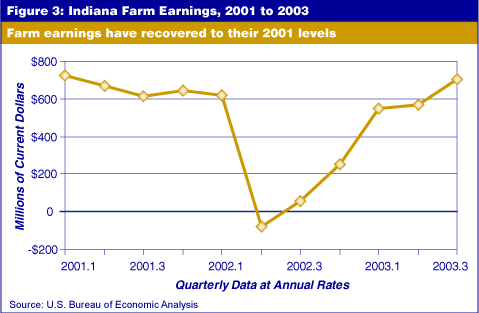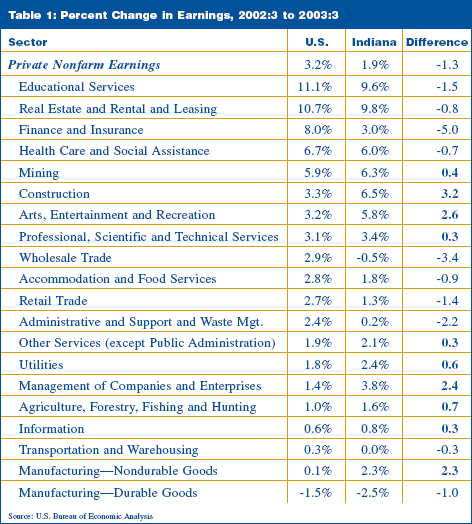Income Shows Slow but Continuing Growth of Indiana Economy
Personal income in Indiana grew by 3.5 percent from the third quarter of 2002 to the same quarter in 2003, compared to a national increase of 3.6 percent. These data, recently released by the U.S. Bureau of Economic Analysis, suggest a stronger picture of economic advancement in Indiana than will be found on closer inspection.
Indiana did well from a regional point of view. Our 3.5 percent increase compared most favorably with the 2.8 percent growth of the Great Lakes region, which was the second poorest performing of eight regions in the nation (see Figure 1). The Plains states had the best performance (4.5 percent) largely due to dramatically increased farm earnings from abnormally low levels a year ago in states that are highly dependent on agriculture.

Among our neighbors, we were in the middle of the pack (see Figure 2). Indiana did better than Ohio, Illinois and Michigan, but those three states were ranked 44th, 46th and 49th, respectively, in the nation. Kentucky, the best of our neighbors, ranked 27th in the United States, while Wisconsin ranked 32nd and Indiana was 36th in personal income growth.

Components of Income
To assess Indiana’s progress, it is necessary to look at the components of personal income. First, let’s examine farm earnings in Figure 3. Since our comparison is from the third quarter of 2002 to the same quarter in 2003, the jump in Indiana farm earnings was most dramatic (1,186 percent). Farm earnings nationwide have recovered to their 2001 levels from a very depressed 2002 experience. With this sudden increase, the growth in farm earnings accounted for 10.8 percent of Indiana’s personal income increase compared to 7.4 percent nationally. But farm earnings, at their revived levels, still equal only 0.4 percent of the state’s personal income.

Another area where Indiana’s growth exceeded that of the nation was unemployment compensation. In Indiana, this form of public assistance grew by 34.4 percent, compared to a national increase of 3.6 percent. Although the dollars count and help sustain our people, such growth is not evidence of an economic advance, but rather reflects the hard times being endured by Hoosiers.
Indiana was adversely affected in the past year by the growth (or rather, the lack thereof) of increased military spending. Nationally, military personnel payments increased by 6.4 percent; in Indiana the increase was a mere 0.9 percent. This is not surprising since we have so few military installations in this state.
The Fate of Private-Sector Earnings
The best way to look at the growth of personal income is to examine what has been happening to private-sector earnings, the wages and salaries of workers plus the income of business proprietors. Table 1 shows the percent changes over the past year in Indiana and the United States.

Table 1 is arranged by the growth rate of business sectors in the country. Overall, U.S. earnings in the nonfarm private sector grew by 3.2 percent, while Indiana trailed at 1.9 percent. In the top four growing sectors, Indiana trailed the nation. In six of the bottom eight sectors, we outperformed the United States. At the extremes, Indiana outperformed the nation by 3.2 percentage points in construction and trailed the country by 5 percentage points in finance and insurance.
In sum, although it would appear that Indiana was just a bit behind the nation in growth of personal income from 2002:3 to 2003:3, in private nonfarm earnings—where it counts most—our advances were weak.
Morton J. Marcus
Director Emeritus, Indiana Business Research Center,
Kelley School of Business, Indiana University
